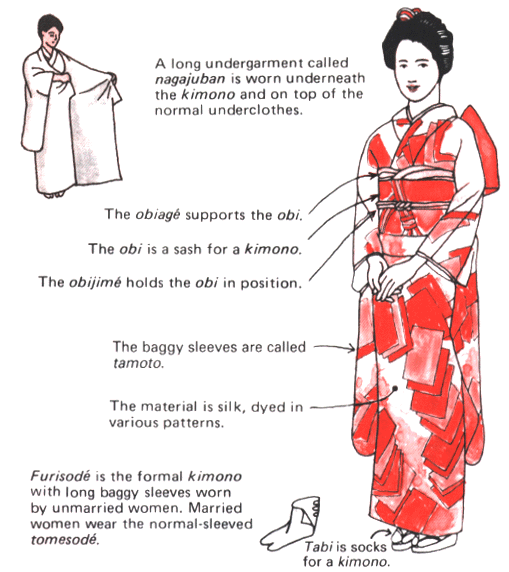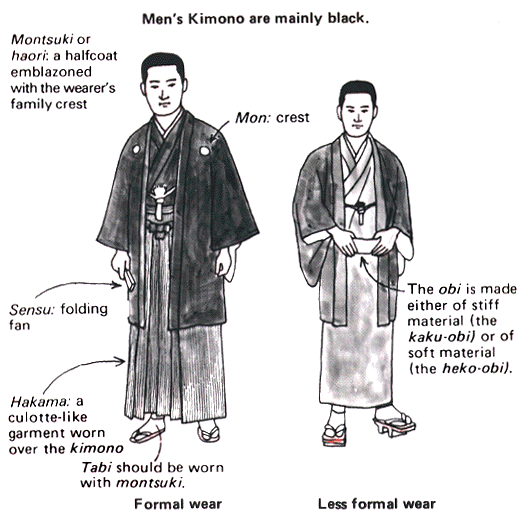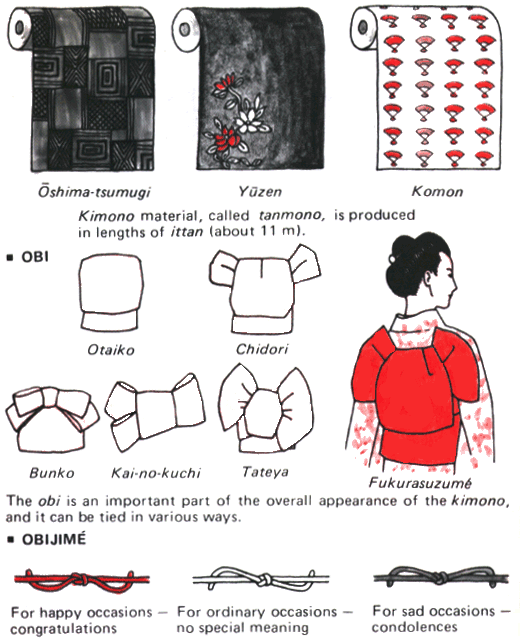Traditional Dress
We start the spring
in our everyday clothes
me and the sparrow
–Issa
The Japanese kimono is one of the world’s instantly recognizable traditional garments. The word kimono literally means “clothing”, and up until the mid 19th century it was the form of dress worn by everyone in Japan. That began to change slowly with the import of suits dresses and other western fashions during the Meiji Era.
Kimono fashion can range from very colorful to quite plain and simple.
Thanks to the popularity of ukiyo-e woodblock prints in the West at the beginning of the last century, the kimono-clad maiden became one of the quintessential images of Japan dressing up in the kimono and other accoutrements of the geiko or meiko is still one of the more popular activities for visiting tourists.
There are different types of kimono for different occasions and seasons, including those worn by men. Other than those worn daily by some older people or performers of traditional arts, kimono are a much less common sight these days but are still widely worn on special occasions such as weddings and graduation ceremonies.
Part of the reason is the cost, as a decent silk kimono will set you back the best part of a million yen. But there is also the question of how to put on the kimono and tie the obi (decorative sash), a complicated procedure that is beyond the ability of many young women. They usually have to ask their mothers to help them or take course at a kimono school.
 |
|||
| yuki – sleeve length | ushiromigoro – rear main section | uraeri – inner collar | doura – upper lining |
| sodetsuke – armhole seam | fuki – hem guard | sode – sleeve | okumi – front panel below the collar |
| miyatsukuchi – opening below armhole | sodeguchi – sleeve opening | tamoto – sleeve pouch | maemigoro – front main section |
| furi – sleeve below armhole | tomoeri – overcollar | eri – collar | susomawashi – lower lining |

The illustration to the left shows how kimono design has changed over the centuries. From around the Nara Period (710-94), a garment called a kosode (small sleeves) was worn, first as underclothes and later as an outer garment, by both women and men. The garment became known as a kimono from the 18th century. Although much less common today than they used to be, even the short-term visitor is likely to see at least one of these elegant garments during their stay.
Women wear kimono when they attend traditional arts, such as a tea ceremony or ikebana class. Girls and young single women wear furisode, a colorful style of kimono with long sleeves and tied with a brightly-colored obi (sash). Kimono made from fabric with simple geometric patterns, called Edo komon, are more plain and casual.
At weddings, the bride and groom will often go through several costume changes. One of them will see the bride in a shiromuku, a heavy, embroidered white kimono and wearing an elaborate hairpiece. The groom wears a black kimono made from habutae silk and carrying the family crest, hakama (a pleated skirt) and a half-length black coat called a haori. Western suits are more common for male guests.
For funerals, both men and women wear plain black kimono. With black suits being suitable for both, it’s often difficult to tell whether a guy is going to a wedding or a funeral except that they wear a white tie for weddings and a black tie for funerals. In January every year, 20-year olds celebrate their coming of age. Most women wear an elaborately-colored komono. Other kimono-wearing occasions include New Year, graduation ceremonies and Shichi-go-san for children.
Traditionally, the art of putting on a kimono was passed from mother to daughter but these days special schools can do brisk business imparting the necessary techniques. The first thing put on are the tabi (white cotton socks); next the undergarments, a top and a wraparound skirt; then the nagajuban, an under-kimono which is tied with a datemaki belt; finally the kimono, with the left side over the right (right over left is only used when dressing a corpse for burial) and tied with the obi. About an inch of the haneri (collar) of the nagajuban shows inside the collar of the kimono. The loose design of the collar is to give a glimpse of the neck, considered the most sensual part of the kimono-wearing lady. When outside, zori sandals are usually worn.
Lined (awase) kimono, traditionally made of silk but sometimes wool or synthetic fabrics, are worn during the cooler months. Light, cotton yukata are worn by men and women during the summer months and after bathing at onsen (hot spring resorts) and ryokan (traditional inns). Often they are worn with geta, informal wooden footwear. Originally worn to the bath house by the upper class and made of plain white cotton, yukata became popular among the common people and were often stencil-dyed. Today, brightly-colored yukata are common at summer festivals and fireworks displays, particularly for young women and children.
 |
|
|
|
|
| There are various different types of kimono for use at different times and on different occasions. Women’s kimono include the furisodé and tomesodé for formal wear, the hômongi for paying calls, the tsukesagé, and the komon. Men’s kimono include the montsuki hakama for ceremonial occasions and the haori for going out visiting. There is also the yukata, worn by both men and women as informal dress at home, in ryokan or for attending local festivals. | |
 |
|
|
|
|
| The shape of kimono is fixed, and individuality is achieved by careful selection of the material, the style of weaving and dyeing, the color, and the pattern, as well as by the choice of obi. | |
 |

